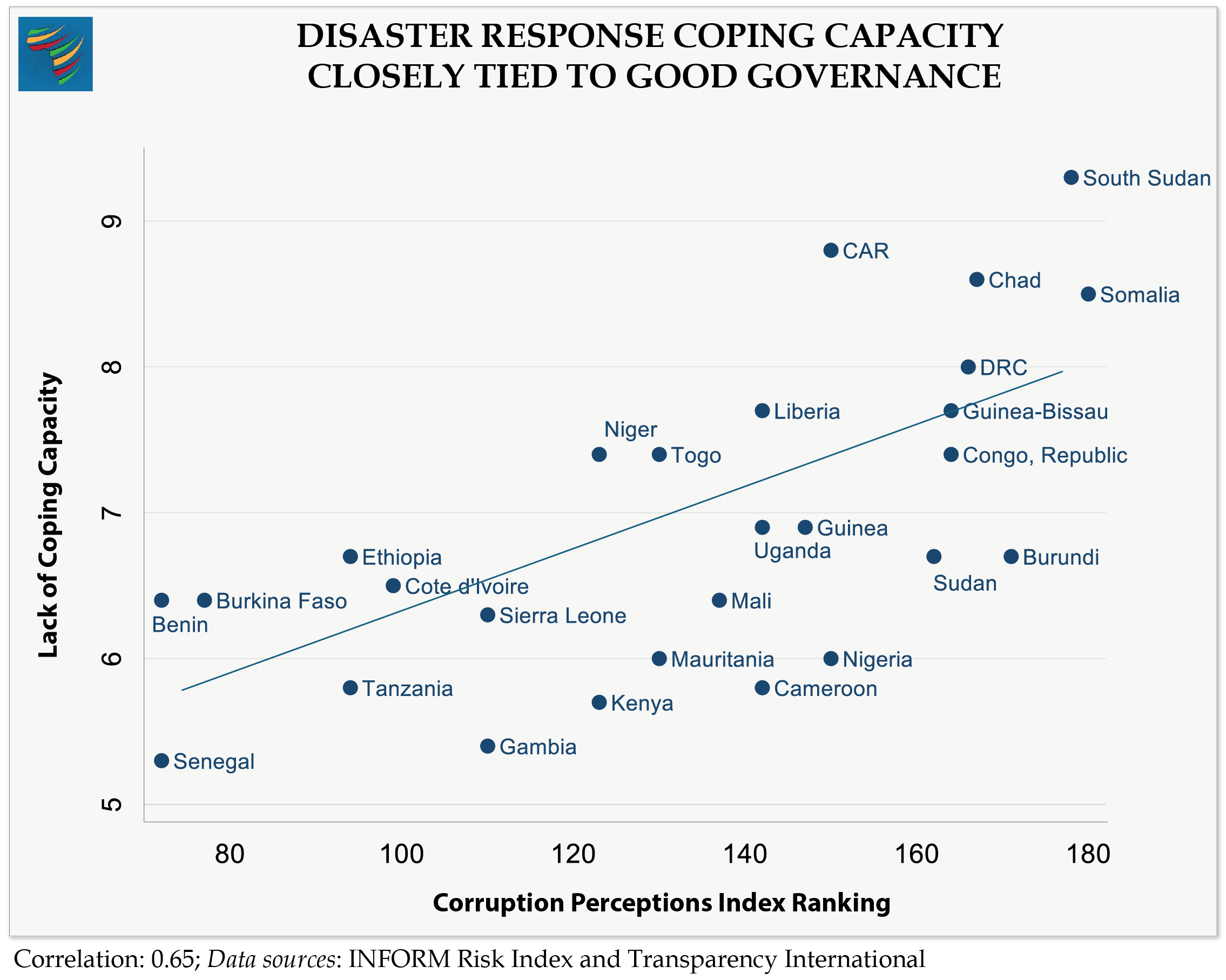
Click here for a full-size map.
Record Rainfall
27 countries in Africa’s tropical zone experienced unusually heavy rainfall in 2024 compared to their historical norms. These increases in the quantity and intensity of rainfall in Africa mirror patterns seen elsewhere around the globe.
Flooding caused by the extensive rainfall impacted roughly 11 million people, resulting in an estimated:
- 2,500 fatalities
- 4 million people displaced
- Millions of hectares of croplands inundated
- Hundreds of thousands of livestock lost
- Hundreds of healthcare facilities destroyed or damaged
- 10 million children in Niger, Nigeria, the Democratic Republic of the Congo (DRC), and Mali being unable to attend school as thousands of schools were flooded or converted into temporary housing for displaced people.
West and Central Africa’s rainy season typically runs from June through September. However, severe flooding persisted into November in central and southern Chad, northern Cameroon, Guinea, Guinea-Bissau, central and southern Mali, southern Niger, northern Nigeria, Senegal, and northern Sierra Leone.
Populations have been further impacted by the associated health risks brought on by the heavy rains and contaminated water supplies (such as a rise in malaria, pneumonia, and cholera).
The 2.4 million people displaced due to the floods have compounded the strain felt from Africa’s record 45 million forcibly displaced people—largely as a result of conflict.
A New Normal?
The 2024 floods in Nigeria, Cameroon, Niger, and Chad are being compared to historic floods that hit these countries in 2022—the result of rainfall that was 20 percent higher than average. In Chad, the 2022 rainfall was the heaviest in 30 years. That 2024 is being compared to these record levels suggests that such extreme weather events may no longer be rare and may be expected to become more frequent.
Annual precipitation data compiled by the World Bank for the nine countries that were most impacted by flooding indicates that 2024 was less an aberration and more a continuation of a pattern of increased rainfall over the past 5 years compared to a baseline from the previous three decades.
- Median levels of rainfall between 2018-2022 in these 9 countries were 6.5 percent greater than the 30-year median from 1988 to 2017.
- Higher temperatures contribute to heavier rainfall. For every 1°C rise in average temperature, the atmosphere can hold up to 7 percent more moisture. Heavier rainfall, in turn, contributes to increased coastal and riverine flooding.
- If temperatures in Africa’s tropical zone continue to remain above normal, the frequency of these widespread flooding events will likely continue to increase.
2024 was less an aberration and more a continuation of a pattern of increased rainfall.
- At times, it is not the amount but the intensity of the rain that is the problem. Dry soil cannot absorb water quickly enough to counter heavy rains. Excess water runs over dry land, leading to flooding. The Sahel, with its arid and semi-arid soils, is highly susceptible to this effect.
- In East Africa, the El Niño weather pattern caused extreme flooding in Burundi, Kenya, Somalia, and Tanzania in the first half of the year.
- In Southern Africa, El Niño’s exacerbation of the region’s driest mid-season period in a century contributed to a catastrophic drought impacting more than 61 million people.
Governance Impacts Countries’ Resiliency to Flooding
While extraordinary levels of rainfall across the tropical zone were the trigger, governance factors have directly contributed to the relative numbers of people affected by flooding.
- Chad, South Sudan, and Niger stand out for the number of people affected by flooding, controlling for population size.
- The nine countries with the largest percentage of people affected by floods are all categorized as “Not Free” by Freedom House. The median Transparency International Corruption Perceptions Index ranking of the nine is 167 (out of 180 countries). Eight of the nine are in conflict.
- The percentage of people affected by the 2024 floods also closely parallels the INFORM Index for Risk Management measure for natural disaster coping capacity. The measure is comprised of a country’s institutional capacity for disaster management, risk reduction, and emergency response and recovery.
The nine countries with the largest percentage of people affected by floods are all categorized as “Not Free.”
- Weak disaster response coping capacity was the indicator with the strongest correlation (0.57, with 1.0 being a perfect correlation) to the percentage of people in a country affected by floods. Other governance measures such as lack of transparency, autocracy, and armed conflict were also strongly correlated (0.42-0.45) to the percentage of people impacted.
- The risk of riverine flooding, by contrast, had a relatively lower correlation (0.37) to the percentage of people affected, underscoring the strong intervening influence governance plays in mitigating the impacts of natural disasters. In other words, extraordinary levels of rainfall were not determinative of large numbers of people affected. Preparedness, mitigation, and responsiveness interventions are also influential for shaping outcomes.
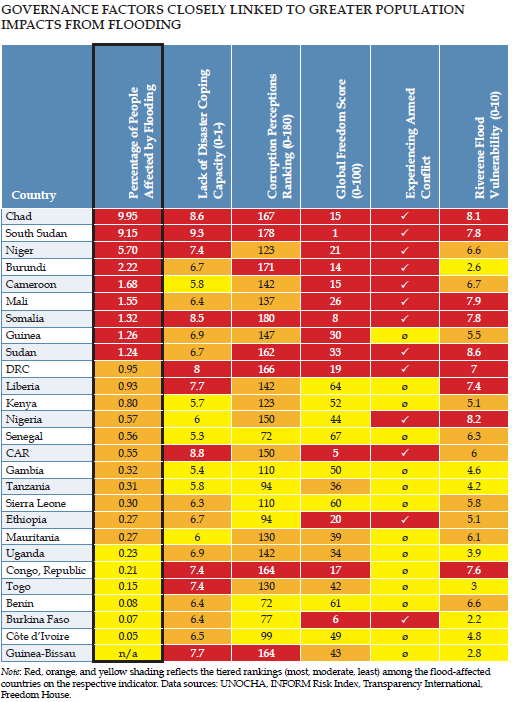
- Even controlling for riverine flood vulnerability and conflict, disaster response coping capacity has a statistically significant correlation with the percentage of people affected by flooding.
- Senegal, The Gambia, Kenya, Tanzania, and Benin, for example, demonstrated relatively stronger resiliency in mitigating the impact on their populations from higher levels of rainfall.
- Disaster response coping capacity, in turn, is closely linked to other governance features like transparency (correlation of 0.65) and democratic governance (0.56).
- The compounding effects of natural disasters on weak governance are illustrated by the pattern of 13 of the 27 flood-affected countries also facing armed conflict. In addition to reflecting elevated levels of societal friction, conflict drains resources away from disaster resiliency and response measures that could be taken.
Illustrations from Selected Countries
Chad
- All 23 of Chad’s provinces were affected by major flooding, with the southwest region’s Lac, Mandoul, Moyen Chari, Tandjilé, and N’Djamena Provinces most severely hit.
- Approximately 1.9 million people in Chad were affected by floods in 2024. Having risen by 8.6 meters, the River Chari has exceeded a previous record of 8.14 meters set during the 2022 floods.
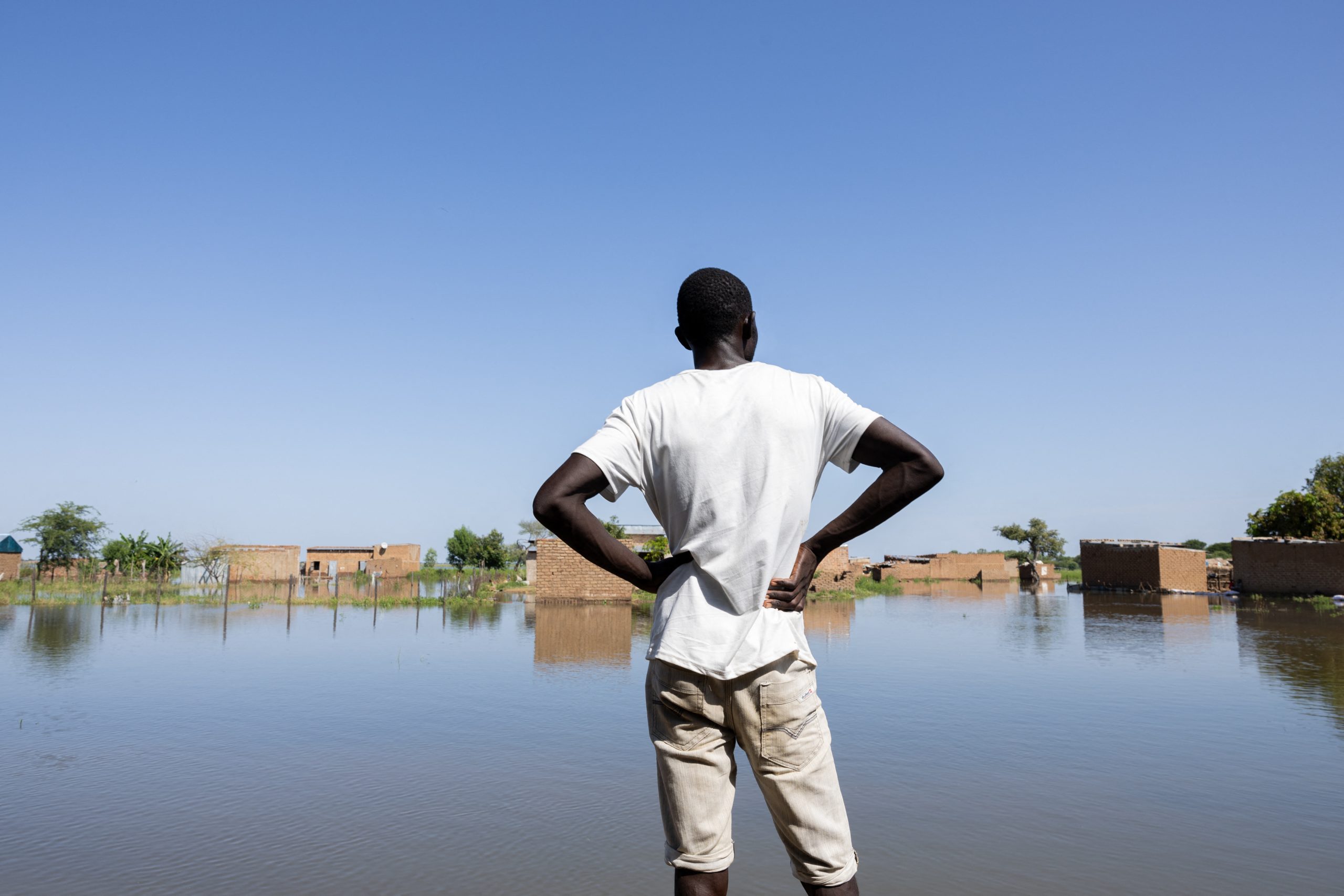
A man looks at floodwaters from the Logone River in the Tougoude neighborhood in Ndjamena on October 8, 2024. (Photo: AFP/Joris Bolomey)
- Around 400,000 hectares of farmland and 70,000 livestock have been lost, while some 13,000 people were displaced from their homes. Authorities reported over 570 deaths from the flooding.
- More than 926,000 people have crossed the border into Chad to escape the conflict in neighboring Sudan. The tents and makeshift shelters of some of those refugees were subsequently destroyed by the floods.
South Sudan
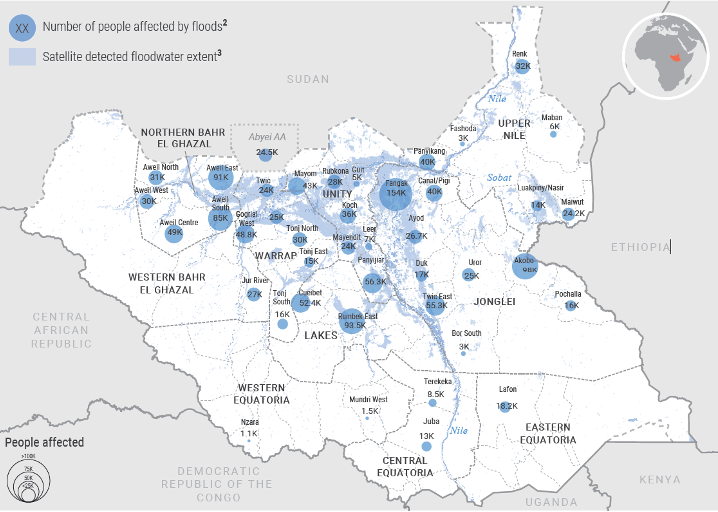
Source: UNOCHA
- 4 million people across 44 counties (out of 79 total) and the Abeyi Administrative Area were affected by heavy rains. Roughly 380,000 people were displaced.
- In September, rainfall and flooding rendered 15 major supply routes impassable, resulting in a delay in the delivery of humanitarian assistance to 500,000 people.
- The United Nations has reported a surge in malaria cases in more than half of the states in South Sudan.
- In areas in Upper Nile State that have become major entry points for refugees fleeing the war in Sudan, humanitarian organizations have reported an alarming rise in cholera cases—with more than 1,500 confirmed and suspected. They attribute the outbreak to a combination of floods, poor access to water, sanitation, and hygiene services, and the wave of refugees from Sudan, where an outbreak of cholera has been raging for months.
Mali
Mali experienced its worst flooding in 60 years with an estimated 370,000 people impacted.
- Mali experienced its worst flooding in 60 years with an estimated 370,000 people impacted. Roughly 17,800 people were displaced.
- Nearly all of the country’s provinces were affected by flooding. The conflict-stricken southcentral Segou region was the worst hit with close to 72,000 people affected. Bamako saw more than 16,000 people impacted, and Timbuktu roughly 37,000, by the floods.
- Due to the lack of free and impartial media in Mali, these impacts may be more extensive than reported.
Sudan
- 15 of Sudan’s 18 states have experienced heavy rains and flooding this year. This impacted over 4 million hectares of land (including 41 percent of the total cropland in the country).
- These floods have occurred amid a devastating conflict that has displaced more than 13.5 million Sudanese.
- Almost 200,000 people were internally displaced (IDPs) by the floods. Over 40 percent of those displaced were already conflict IDPs.
- Illustrative of the compounding effect, 50 trucks carrying nearly 5,000 tons of food assistance were stranded across Sudan in August due to flooding and impassable roads. This has been particularly devastating given that humanitarian access has been highly constricted throughout the Sudan conflict.
Nigeria
- 34 of Nigeria’s 36 states were impacted by heavy rains this year. The North East region was particularly heavily hit. The Alau Dam on the Ngadda River in Borno State overflowed in September, inundating two-thirds of the state capital, Maiduguri, killing 1,000 people. Authorities called it the worst flooding in 30 years.
- Almost 4 million people across the country were affected by the floods. Roughly 260,000 hectares of cropland were lost, and more than 740,000 people nationally were displaced.
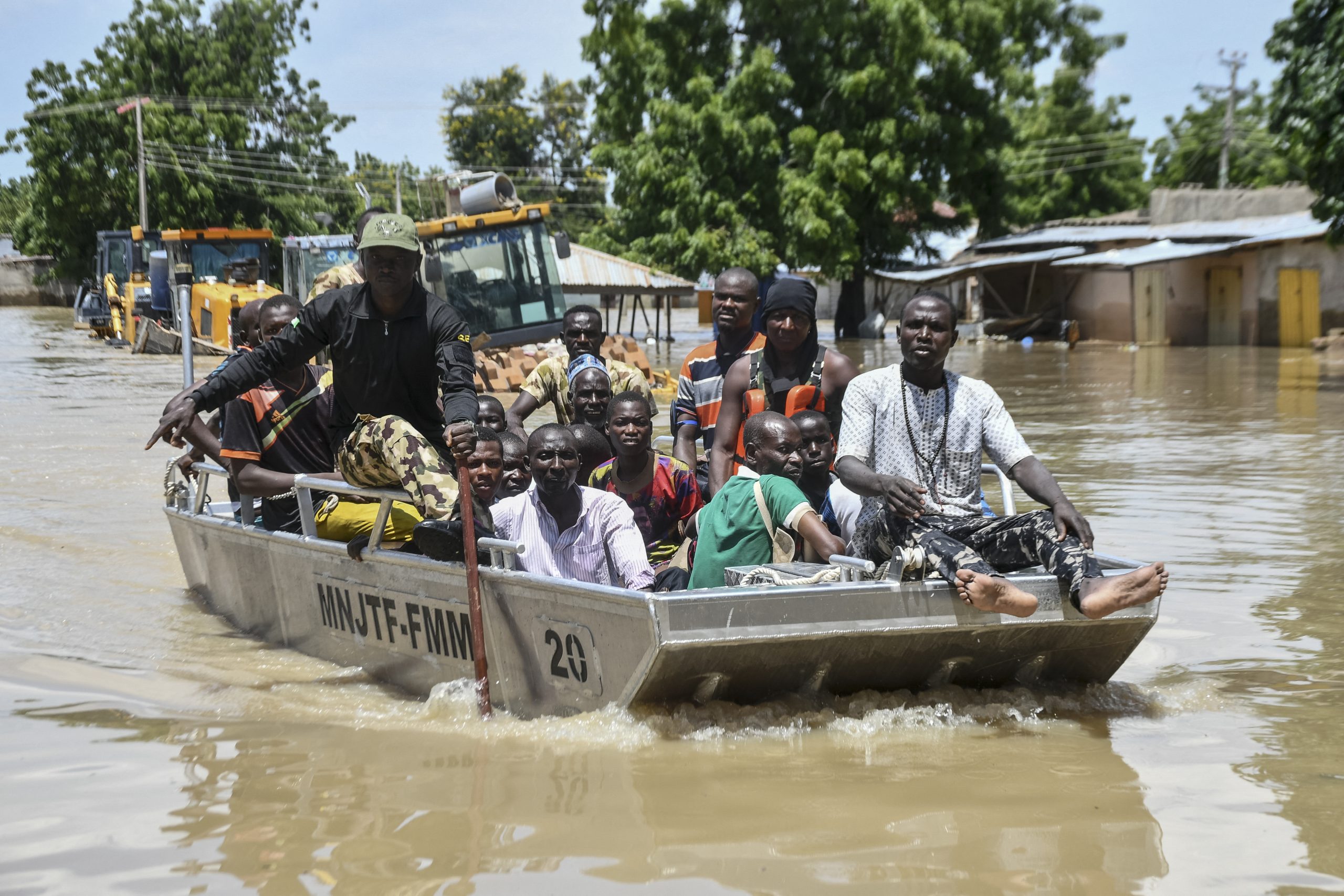
People affected by floods are escorted through flood water on a MNJTF boat in Maiduguri, Nigeria on September 12, 2024. (Photo: AFP/Audu MARTE)
- Maiduguri already hosted hundreds of thousands of people displaced by Boko Haram and Islamic State in West Africa violence. The floods forced authorities to evacuate many of these displaced people while generating an additional 300,000 IDPs in the region. The government’s response has helped mitigate further flood related impacts in the region, however.
- The Nigerian Center for Disease Control announced that the country had recorded nearly 11,000 cases of cholera in 2024—a 220-percent increase compared with the same time frame in 2023. Fatalities due to cholera increased from 106 to 359. Borno State, one of the regions hardest hit by the floods and the locus of militant Islamist attacks, accounted for a significant number of cholera cases.
Senegal
- According to the Institute for Research and Development in Senegal, the 2024 rainfall exceeded the seasonal norm by 30 percent.
- A rise in the Senegal and Gambia Rivers led to severe flooding in the surrounding areas affecting scores of farmers who had moved closer to the river banks to reduce the cost of irrigation following periods of drought.
- Submerged fields destroyed crops that were ready for harvesting. According to the National Society for the Development and Exploitation of the Land of the Senegal River Delta (SAED), as a result of the floods “thousands of households will be tipping into extreme poverty.”
- In October, the Senegalese army was mobilized to evacuate people and livestock from the affected regions, President Bassirou Diomaye Faye visited the flood zones, and Prime Minister Ousmane Sonko announced the allocation of roughly $13 million to support flood victims.
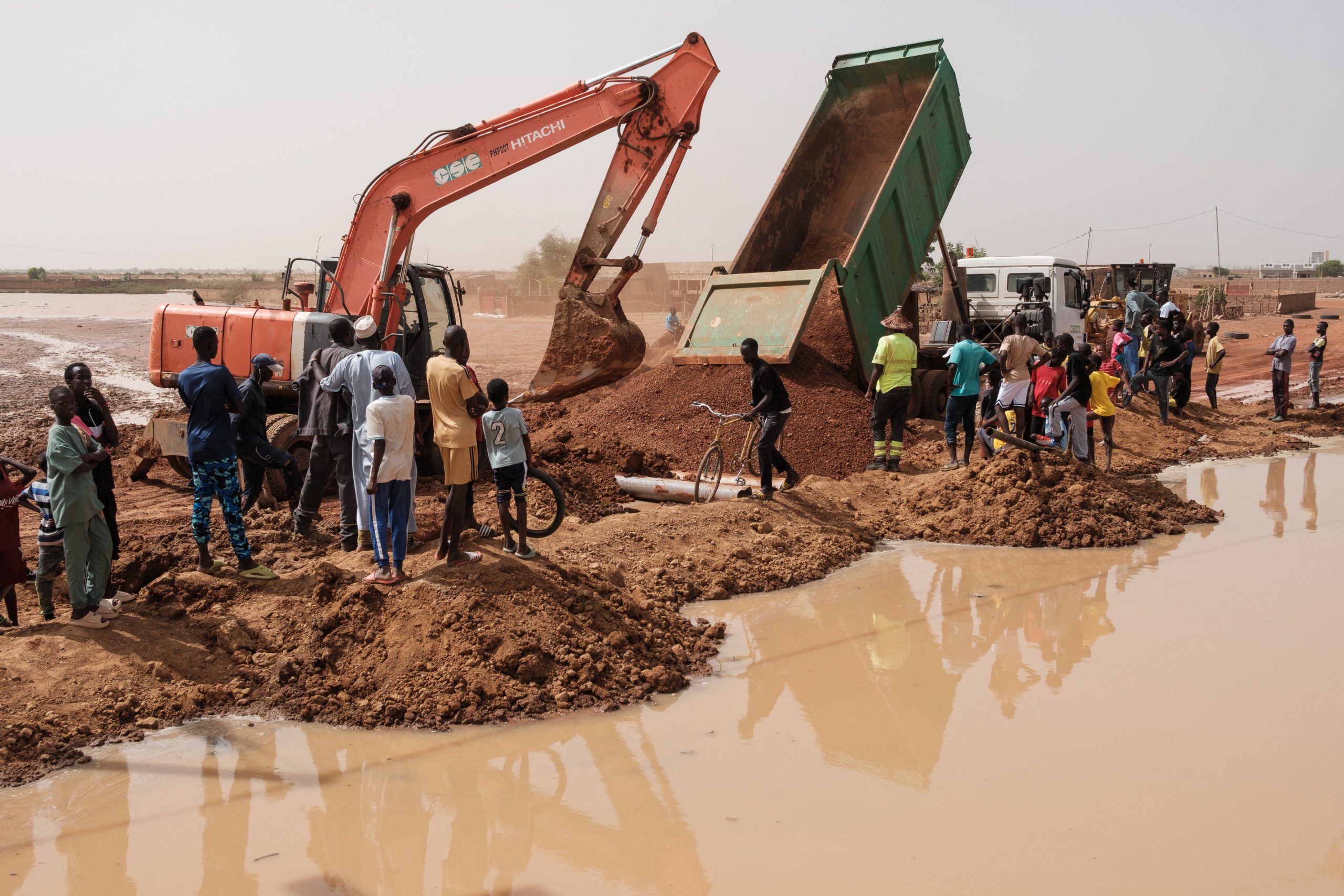
A volunteer construction team dumps soil to make a dam and rebuild a main road destroyed during major flooding in Senegal on October 21, 2024. (Photo: AFP/GUY PETERSON)
Kenya
Responding to early warning signals sent out by its meteorology department in advance of the rainy season, the Kenyan government took steps to mitigate the impact of the flooding.
- Kenya was hit hard by El Niño-induced rainfall and subsequent flooding. More than 400,000 people were affected, including the displacement of 40,000 households living in Nairobi’s informal settlements.
- Responding to early warning signals sent out by its meteorology department in advance of the rainy season, the Kenyan government took steps to mitigate the impact of the flooding.
- Kenya’s Ministry of Health deployed an incident management system team for disease surveillance, case management, and risk communication. The ministry also established medical camps to provide care for more than 4,000 people who were affected by the closure of health centers due to the flooding.
- More than 700 first responders were prepared to deploy to displacement camps to provide health services to refugees.
Additional Resources
- Austyn Gaffney and Somini Sengupta, “Floods Wreak Havoc over Four Continents,” New York Times, September 19, 2024.
- Laura Jaramillo, Aliona Cebotari, Yoro Diallo, Rhea Gupta, Yugo Koshima, Chandana Kularatne, Daniel Jeong Dae Lee, Sidra Rehman, Kalin Tintchev, and Fang Yang, “Climate Challenges in Fragile and Conflict-Affected States,” International Monetary Fund, August 30, 2023.
- Africa Center for Strategic Studies, “Cycles of Escalating Threats Facing Africa from Global Warming,” Infographic, June 17, 2022.
- Africa Center for Strategic Studies, “Cyclones and More Frequent Storms Threaten Africa,” Infographic, May 24, 2022.
- Francois A. Engelbrecht, Pedro M.S. Monteiro, “The IPCC Assessment Report Six Working Group 1 Report and Southern Africa: Reasons to Take Action,” South African Journal of Science 117, no. 11-12 (2021).
- Africa Center for Strategic Studies, “How Global Warming Threatens Human Security in Africa,” Infographic, October 29, 2021.
More On: Environment and Security Sahel Nigeria Sudan



